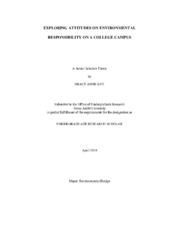| dc.description.abstract | The primary intention of this project is to determine the driving factors that would encourage environmental responsibility on a college campus. After observing increases in "global average air and ocean temperatures," the Intergovernmental Panel on Climate Change concluded that global warming is unmistakable. In order to reduce our negative impact on the environment, we need to take action. Many college campuses are moving toward more sustainable practices, such as energy efficient buildings, but these are not always translated into a more environmentally responsible student body. My methods consisted of both qualitative and quantitative research approaches. The qualitative section consisted of an extensive review of existing literature. This produced a best practices report of the most sustainable colleges in America. The quantitative portion was comprised of the development and administration of a survey. The survey questioned students on their attitudes on green behavior, attitudes and knowledge of the best green practices on a college campus, and their current green behaviors. The highlighted factors in the survey were incentive, convenience, ethics, and awareness.
The target audience was members of the National Society of Collegiate Scholars from Texas A&M and the University of Colorado - Boulder, one of the most sustainable schools in the country. The survey results were compared to determine any significant differences. The results showed that convenience and awareness are the driving factors in sustainable student behavior. Incentive and ethics can be considered cultural factors that vary by region. These factors can be reduced by the driving factors. I believe a compromise can be reached at Texas A&M between attitudes and behaviors to create an environment that encourages a more sustainable student body. | en |


